Coupling a Physical Replica with a Digital Twin: A Comparison of Participatory Decision-Making Methods in an Urban Park Environment
Abstract
1. Introduction
- How do we build a digital twin system of urban parks to support scenario simulation and spatial decision making in a participatory workshop?
- What are the differences in the participants’ evaluations when comparing the digital twin model with the physical replica?
- How do participants’ evaluations of the two models associate with their sociodemographics?
2. Background and Related Work
2.1. The Concept and Method of Participatory Design
2.2. Digital Twin System and Virtual Participation
3. Methodology and Study Area
3.1. Study Area
3.2. Digital Twin Park Construction
3.2.1. Real Scene Modeling Using UAV Oblique Photography
- 1.
- Aerial survey: To reduce the effect of shadows on the 3D accurate scene model, we flew the drone on cloudy days when the solar altitude angle was larger than 30 degrees for aerial surveys. During the survey, we set 300 flight routes (a course overlap rate of 80% and a side overlap rate of 70%) with a flying altitude of 30 m. Flying route planning was carried out through the DJI RTK app, and 7200 aerial images with positioning and orientation system (POS) information were obtained.
- 2.
- Aerial triangulation: We then imported the aerial images from the previous step with POS information into ContextCapture software. We used the oblique photos taken from different angles to reconstruct 3D models of ground objects.
- 3.
- 3D modeling: We divided the site model constructed from the previous step into 10 tiles to build a mesh model of the area. The oblique images automatically mapped the texture information. Consequently, we generated a near real-world 3D model of the park, as shown in Figure 2.
3.2.2. Digital Twin Park Design
3.2.3. Software and Pre-Settings for the Participatory Workshops
3.3. Physical Replica Construction
3.4. Participatory Workshop in Nancuiping Park
4. Results
4.1. Participation Results
4.2. Statistical Analysis
5. Discussion
- Collaboration: The digital twin can be a collaborative platform linking residents with urban designers in a participatory workshop. It allows participants to interact with all the objects in the digital twin and tag issues and provide comments on urban design plans to support the decision making of urban designers.
- High-precision built environment assessment: It organizes spatial and texture information of the built environment into multiple levels, such as plants, water bodies, and roads and squares, thus supporting accurate landscape management and built environment assessment.
- Solution-driven comparisons: Although the digital twin models can be challenging to be used with the general public in a straightforward manner, from the urban designer’s perspective, the models provide the opportunity for solution-driven comparisons of different designs to find the most suitable plans for urban space planning. The Participation Results section illustrates a range of simulations that can be carried out using a digital twin of the urban built environment, which is conducive to improving the accuracy and interactivity of planning and design.
6. Conclusions
Author Contributions
Funding
Institutional Review Board Statement
Informed Consent Statement
Data Availability Statement
Acknowledgments
Conflicts of Interest
References
- Halkos, G.; Leonti, A.; Sardianou, E. Activities, motivations and satisfaction of urban parks visitors: A structural equation modeling analysis. Econ. Anal. Policy 2021, 70, 502–513. [Google Scholar] [CrossRef]
- Huai, S.; Van de Voorde, T. Which environmental features contribute to positive and negative perceptions of urban parks? A cross-cultural comparison using online reviews and Natural Language Processing methods. Landsc. Urban Plan. 2022, 218, 104307. [Google Scholar] [CrossRef]
- Kabisch, N.; Kraemer, R.; Masztalerz, O.; Hemmerling, J.; Püffel, C.; Haase, D. Impact of summer heat on urban park visitation, perceived health and ecosystem service appreciation. Urban For. Urban Green. 2021, 60, 127058. [Google Scholar] [CrossRef]
- Peng, J.; Dan, Y.; Qiao, R.; Liu, Y.; Dong, J.; Wu, J. How to quantify the cooling effect of urban parks? Linking maximum and accumulation perspectives. Remote Sens. Environ. 2021, 252, 112135. [Google Scholar] [CrossRef]
- Mäntymaa, E.; Jokinen, M.; Juutinen, A.; Lankia, T.; Louhi, P. Providing ecological, cultural and commercial services in an urban park: A travel cost–contingent behavior application in Finland. Landsc. Urban Plan. 2021, 209, 104042. [Google Scholar] [CrossRef]
- Silva, L.T.; Fonseca, F.; Pires, M.; Mendes, B. SAUS: A tool for preserving urban green areas from air pollution. Urban For. Urban Green. 2019, 46, 126440. [Google Scholar] [CrossRef]
- Han, D.; Zhang, C.; Wang, C.; She, J.; Sun, Z.; Zhao, D.; Bian, Q.; Han, W.; Yin, L.; Sun, R.; et al. Differences in response of butterfly diversity and species composition in urban parks to land cover and local habitat variables. Forests 2021, 12, 140. [Google Scholar] [CrossRef]
- Wang, P.; Zhou, B.; Han, L.; Mei, R. The motivation and factors influencing visits to small urban parks in Shanghai, China. Urban For. Urban Green. 2021, 60, 127086. [Google Scholar] [CrossRef]
- leBrasseur, R. Cultural Greenspaces: Synthesizing Knowledge and Experience in Nova Scotia’s African-Canadian Communities through Participatory Research and SoftGIS. Soc. Sci. 2022, 11, 281. [Google Scholar] [CrossRef]
- Yang, J.; Yang, L.; Ma, H. Community Participation Strategy for Sustainable Urban Regeneration in Xiamen, China. Land 2022, 11, 600. [Google Scholar] [CrossRef]
- Główczyński, M. Toward User-Generated Content as a Mechanism of Digital Placemaking—Place Experience Dimensions in Spatial Media. ISPRS Int. J. Geo-Inf. 2022, 11, 261. [Google Scholar] [CrossRef]
- Speller, G.; Ravenscroft, N. Facilitating and evaluating public participation in urban parks management. Local Environ. 2005, 10, 41–56. [Google Scholar] [CrossRef]
- Geekiyanage, D.; Fernando, T.; Keraminiyage, K. Mapping participatory methods in the urban development process: A systematic review and case-based evidence analysis. Sustainability 2021, 13, 8992. [Google Scholar] [CrossRef]
- McEvoy, S.; van de Ven, F.H.; Blind, M.W.; Slinger, J.H. Planning support tools and their effects in participatory urban adaptation workshops. J. Environ. Manag. 2018, 207, 319–333. [Google Scholar] [CrossRef]
- Street, P. Scenario workshops: A participatory approach to sustainable urban living? Futures 1997, 29, 139–158. [Google Scholar] [CrossRef]
- Chen, F.; Chen, Y. Urban Metabolism and Spontaneous Architectural Growth: A Sustainable Strategy Featuring Participatory Co-Construction by Multiple Stakeholders. Buildings 2022, 12, 352. [Google Scholar] [CrossRef]
- De Siqueira, G.; Malaj, S.; Hamdani, M. Digitalization, Participation and Interaction: Towards More Inclusive Tools in Urban Design—A Literature Review. Sustainability 2022, 14, 4514. [Google Scholar] [CrossRef]
- Pánek, J. Emotional maps: Participatory crowdsourcing of citizens perceptions of their urban environment. Cartogr. Perspect. 2018, 91, 17–29. [Google Scholar] [CrossRef]
- Postert, P.; Wolf, A.E.; Schiewe, J. Integrating Visualization and Interaction Tools for Enhancing Collaboration in Different Public Participation Settings. ISPRS Int. J. Geo-Inf. 2022, 11, 156. [Google Scholar] [CrossRef]
- Schrotter, G.; Hürzeler, C. The digital twin of the city of Zurich for urban planning. PFG–J. Photogramm. Remote Sens. Geoinf. Sci. 2020, 88, 99–112. [Google Scholar] [CrossRef]
- Scalas, A.; Cabiddu, D.; Mortara, M.; Spagnuolo, M. Potential of the Geometric Layer in Urban Digital Twins. ISPRS Int. J. Geo-Inf. 2022, 11, 343. [Google Scholar] [CrossRef]
- Tzachor, A.; Sabri, S.; Richards, C.E.; Rajabifard, A.; Acuto, M. Potential and limitations of digital twins to achieve the Sustainable Development Goals. Nat. Sustain. 2022, 1–8. [Google Scholar] [CrossRef]
- Redelinghuys, A.; Basson, A.H.; Kruger, K. A six-layer architecture for the digital twin: A manufacturing case study implementation. J. Intell. Manuf. 2020, 31, 1383–1402. [Google Scholar] [CrossRef]
- White, G.; Zink, A.; Codecá, L.; Clarke, S. A digital twin smart city for citizen feedback. Cities 2021, 110, 103064. [Google Scholar] [CrossRef]
- Shahat, E.; Hyun, C.T.; Yeom, C. City digital twin potentials: A review and research agenda. Sustainability 2021, 13, 3386. [Google Scholar] [CrossRef]
- Kikuchi, N.; Fukuda, T.; Yabuki, N. Landscape Visualization by Integrating Augmented Reality and Drones with Occlusion Handling to Link Real and Virtual Worlds-Towards city digital twin realization. In Proceedings of the 39th eCAADe Conference, Novi Sad, Serbia, 8–10 September 2021; pp. 521–528. [Google Scholar]
- Ham, Y.; Kim, J. Participatory sensing and digital twin city: Updating virtual city models for enhanced risk-informed decision-making. J. Manag. Eng. 2020, 36, 04020005. [Google Scholar] [CrossRef]
- Nochta, T.; Parlikad, A.; Schooling, J.; Badstuber, N.; Wahby, N. The Local Governance of Digital Technology–Implications for the City-Scale Digital Twin; Cambridge University: Cambridge, MA, USA, 2019. [Google Scholar]
- Charitonidou, M. Urban scale digital twins in data-driven society: Challenging digital universalism in urban planning decision-making. Int. J. Archit. Comput. 2022, 20, 14780771211070005. [Google Scholar] [CrossRef]
- Mukhopadhyay, A.; Reddy, G.R.; Saluja, K.S.; Ghosh, S.; Peña-Rios, A.; Gopal, G.; Biswas, P. Virtual-reality-based digital twin of office spaces with social distance measurement feature. Virtual Real. Intell. Hardw. 2022, 4, 55–75. [Google Scholar] [CrossRef]
- Taylor, N. Urban Planning Theory Since 1945; Sage: Thousand Oaks, CA, USA, 1998. [Google Scholar]
- Li, X.; Zhang, F.; Hui, E.C.m.; Lang, W. Collaborative workshop and community participation: A new approach to urban regeneration in China. Cities 2020, 102, 102743. [Google Scholar] [CrossRef]
- Groulx, M.; Lemieux, C.; Freeman, S.; Cameron, J.; Wright, P.A.; Healy, T. Participatory planning for the future of accessible nature. Local Environ. 2021, 26, 808–824. [Google Scholar] [CrossRef]
- Enserink, B.; Koppenjan, J. Public participation in China: Sustainable urbanization and governance. Manag. Environ. Qual. 2007, 18, 459–474. [Google Scholar] [CrossRef]
- Li, Y.; Cheng, H.; Beeton, R.J.; Sigler, T.; Halog, A. Sustainability from a Chinese cultural perspective: The implications of harmonious development in environmental management. Environ. Dev. Sustain. 2016, 18, 679–696. [Google Scholar] [CrossRef]
- Semeraro, T.; Zaccarelli, N.; Lara, A.; Sergi Cucinelli, F.; Aretano, R. A bottom-up and top-down participatory approach to planning and designing local urban development: Evidence from an urban university center. Land 2020, 9, 98. [Google Scholar] [CrossRef]
- Sim, T.; Dominelli, L.; Lau, J. A Pathway to Initiate Bottom-Up Community-Based Disaster Risk Reduction within a Top-Down System: The Case of China; WIT Press: Southampton, UK, 2017. [Google Scholar]
- El Asmar, J.P.; Ebohon, J.O.; Taki, A. Bottom-up approach to sustainable urban development in Lebanon: The case of Zouk Mosbeh. Sustain. Cities Soc. 2012, 2, 37–44. [Google Scholar] [CrossRef]
- Pettit, C.; Nelson, A.; Cartwright, W. Using on-line geographical visualisation tools to improve land use decision-making with a bottom-up community participatory approach. In Recent Advances in Design and Decision Support Systems in Architecture and Urban Planning; Springer: Berlin/Heidelberg, Germany, 2004; pp. 53–68. [Google Scholar]
- Pogačar, K.; Žižek, A. Urban hackathon–alternative information based and participatory approach to urban development. Procedia Eng. 2016, 161, 1971–1976. [Google Scholar] [CrossRef][Green Version]
- Li, Y.; Beeton, R.J.; Sigler, T.; Halog, A. Enhancing the adaptive capacity for urban sustainability: A bottom-up approach to understanding the urban social system in China. J. Environ. Manag. 2019, 235, 51–61. [Google Scholar] [CrossRef]
- Ortiz Escalante, S.; Gutiérrez Valdivia, B. Planning from below: Using feminist participatory methods to increase women’s participation in urban planning. Gend. Dev. 2015, 23, 113–126. [Google Scholar] [CrossRef]
- Lawrence, D.; Christodoulou, N.; Whish, J. Designing better on-farm research in Australia using a participatory workshop process. Field Crop. Res. 2007, 104, 157–164. [Google Scholar] [CrossRef]
- Salter, J.D.; Campbell, C.; Journeay, M.; Sheppard, S.R. The digital workshop: Exploring the use of interactive and immersive visualisation tools in participatory planning. J. Environ. Manag. 2009, 90, 2090–2101. [Google Scholar] [CrossRef]
- Nikologianni, A.; Betta, A.; Gretter, A. Contribution of Conceptual-Drawing Methods to Raise Awareness on Landscape Connectivity: Socio-Environmental Analysis in the Regional Context of Trentino (Italy). Sustainability 2022, 14, 7975. [Google Scholar] [CrossRef]
- Akbar, A.; Flacke, J.; Martinez, J.; van Maarseveen, M.F. The Role of Participatory Village Maps in Strengthening Public Participation Practice. ISPRS Int. J. Geo-Inf. 2021, 10, 512. [Google Scholar] [CrossRef]
- Kenny, D.C.; Castilla-Rho, J. No Stakeholder Is an Island: Human Barriers and Enablers in Participatory Environmental Modelling. Land 2022, 11, 340. [Google Scholar] [CrossRef]
- Neuenschwander, N.; Hayek, U.W.; Grêt-Regamey, A. Integrating an urban green space typology into procedural 3D visualization for collaborative planning. Comput. Environ. Urban Syst. 2014, 48, 99–110. [Google Scholar] [CrossRef]
- El Saddik, A. Digital twins: The convergence of multimedia technologies. IEEE Multimed. 2018, 25, 87–92. [Google Scholar] [CrossRef]
- Glaessgen, E.; Stargel, D. The digital twin paradigm for future NASA and US Air Force vehicles. In Proceedings of the 53rd AIAA/ASME/ASCE/AHS/ASC Structures, Structural Dynamics and Materials Conference 20th AIAA/ASME/AHS Adaptive Structures Conference 14th AIAA, Honolulu, HI, USA, 23–26 April 2012; p. 1818. [Google Scholar]
- Tao, F.; Cheng, J.; Qi, Q.; Zhang, M.; Zhang, H.; Sui, F. Digital twin-driven product design, manufacturing and service with big data. Int. J. Adv. Manuf. Technol. 2018, 94, 3563–3576. [Google Scholar] [CrossRef]
- Mohammadi, N.; Taylor, J. Knowledge discovery in smart city digital twins. In Proceedings of the 53rd Hawaii International Conference on System Sciences, Maui, HI, USA, 7–10 January 2020. [Google Scholar]
- Luo, W.; Hu, T.; Zhang, C.; Wei, Y. Digital twin for CNC machine tool: Modeling and using strategy. J. Ambient. Intell. Humaniz. Comput. 2019, 10, 1129–1140. [Google Scholar] [CrossRef]
- Havard, V.; Jeanne, B.; Lacomblez, M.; Baudry, D. Digital twin and virtual reality: A co-simulation environment for design and assessment of industrial workstations. Prod. Manuf. Res. 2019, 7, 472–489. [Google Scholar] [CrossRef]
- Kuts, V.; Otto, T.; Bondarenko, Y.; Yu, F. Digital twin: Collaborative virtual reality environment for multi-purpose industrial applications. In Proceedings of the ASME International Mechanical Engineering Congress and Exposition. American Society of Mechanical Engineers, Virtual, 16–19 November 2020; Volume 84492, p. V02BT02A010. [Google Scholar]
- Singh, M.; Fuenmayor, E.; Hinchy, E.P.; Qiao, Y.; Murray, N.; Devine, D. Digital twin: Origin to future. Appl. Syst. Innov. 2021, 4, 36. [Google Scholar] [CrossRef]
- Dembski, F.; Wössner, U.; Letzgus, M.; Ruddat, M.; Yamu, C. Urban digital twins for smart cities and citizens: The case study of Herrenberg, Germany. Sustainability 2020, 12, 2307. [Google Scholar] [CrossRef]
- Ruohomäki, T.; Airaksinen, E.; Huuska, P.; Kesäniemi, O.; Martikka, M.; Suomisto, J. Smart city platform enabling digital twin. In Proceedings of the 2018 International Conference on Intelligent Systems (IS), Wroclaw, Poland, 17–18 September 2018; pp. 155–161. [Google Scholar]
- Deng, T.; Zhang, K.; Shen, Z.J.M. A systematic review of a digital twin city: A new pattern of urban governance toward smart cities. J. Manag. Sci. Eng. 2021, 6, 125–134. [Google Scholar] [CrossRef]
- Shirowzhan, S.; Tan, W.; Sepasgozar, S.M. Digital twin and CyberGIS for improving connectivity and measuring the impact of infrastructure construction planning in smart cities. ISPRS Int. J. Geo-Inf. 2020, 9, 240. [Google Scholar] [CrossRef]
- Levine, N.M.; Spencer Jr, B.F. Post-earthquake building evaluation using UAVs: A BIM-based digital twin framework. Sensors 2022, 22, 873. [Google Scholar] [CrossRef] [PubMed]
- Lim, S.H.; Choi, K.M.; Cho, G.S. A study on 3D model building of drones-based urban digital twin. J. Cadastre Land InformatiX 2020, 50, 163–180. [Google Scholar]
- Mohammadi, M.; Rashidi, M.; Mousavi, V.; Karami, A.; Yu, Y.; Samali, B. Case study on accuracy comparison of digital twins developed for a heritage bridge via UAV photogrammetry and terrestrial laser scanning. In Proceedings of the 10th International Conference on Structural Health Monitoring of Intelligent Infrastructure, Tokyo, Japan, 30 June–2 July 2021; Volume 10. [Google Scholar]
- Mihoković, V.; Zalović, L.; Zalović, V. Establishing the utility charges spatial database using digital twin technology. In Proceedings of the 2020 43rd International Convention on Information, Communication and Electronic Technology (MIPRO), Opatija, Croatia, 28 September–2 October 2020; pp. 437–441. [Google Scholar]
- Mohammadi, M.; Rashidi, M.; Mousavi, V.; Karami, A.; Yu, Y.; Samali, B. Quality evaluation of digital twins generated based on UAV photogrammetry and TLS: Bridge case study. Remote Sens. 2021, 13, 3499. [Google Scholar] [CrossRef]
- Skondras, A.; Karachaliou, E.; Tavantzis, I.; Tokas, N.; Valari, E.; Skalidi, I.; Bouvet, G.A.; Stylianidis, E. UAV Mapping and 3D Modeling as a Tool for Promotion and Management of the Urban Space. Drones 2022, 6, 115. [Google Scholar] [CrossRef]
- Lai, F.; Bush, A.; Yang, X.; Merrick, D. Opportunities and Challenges of Unmanned Aircraft Systems for Urban Applications. In Urban Remote Sensing: Monitoring, Synthesis, and Modeling in the Urban Environment; John Wiley & Sons Ltd.: Hoboken, NJ, USA, 2021; pp. 47–69. [Google Scholar]
- Wu, B.; Xie, L.; Hu, H.; Zhu, Q.; Yau, E. Integration of aerial oblique imagery and terrestrial imagery for optimized 3D modeling in urban areas. ISPRS J. Photogramm. Remote Sens. 2018, 139, 119–132. [Google Scholar] [CrossRef]
- Zhang, Y.; Meina, A.; Lin, X.; Zhang, K.; Xu, Z. Digital twin in computational design and robotic construction of wooden architecture. Adv. Civ. Eng. 2021, 2021. [Google Scholar] [CrossRef]
- Hadiyatna, W.; Harapan, A. Use of 3D animation software in visualizing architectural works. In IOP Conference Series: Materials Science and Engineering; IOP Publishing: Bristol, UK, 2020; Volume 879, p. 012147. [Google Scholar]
- Saßmannshausen, S.M.; Radtke, J.; Bohn, N.; Hussein, H.; Randall, D.; Pipek, V. Citizen-Centered Design in Urban Planning: How Augmented Reality can be used in Citizen Participation Processes. In Proceedings of the Designing Interactive Systems Conference 2021, Virtual, 28 June–2 July 2021; pp. 250–265. [Google Scholar]
- Krishnamurthy, S. Reclaiming spaces: Child inclusive urban design. Cities Health 2019, 3, 86–98. [Google Scholar] [CrossRef]
- Carroll, P.; Witten, K.; Asiasiga, L.; Lin, E.Y. Children’s engagement as urban researchers and consultants in Aotearoa/New Zealand: Can it increase children’s effective participation in urban planning? Child. Soc. 2019, 33, 414–428. [Google Scholar] [CrossRef]
- Ataol, Ö.; Krishnamurthy, S.; van Wesemael, P. Children’s participation in urban planning and design: A systematic review. Child. Youth Environ. 2019, 29, 27–47. [Google Scholar] [CrossRef]
- Smith, F. Children’s Voices and the Construction of Children’s Spaces: The Example of Playcare Centers in the United Kingdom. Child. Environ. 1995, 12, 389–396. [Google Scholar]
- Liu, Q.; Zhu, Z.; Zhuo, Z.; Huang, S.; Zhang, C.; Shen, X.; van den Bosch, C.C.K.; Huang, Q.; Lan, S. Relationships between residents’ ratings of place attachment and the restorative potential of natural and urban park settings. Urban For. Urban Green. 2021, 62, 127188. [Google Scholar] [CrossRef]
- Li, J.; Krishnamurthy, S.; Roders, A.P.; van Wesemael, P. Informing or consulting? Exploring community participation within urban heritage management in China. Habitat Int. 2020, 105, 102268. [Google Scholar] [CrossRef]
- Rakotomahazo, C.; Razanoelisoa, J.; Ranivoarivelo, N.L.; Todinanahary, G.G.B.; Ranaivoson, E.; Remanevy, M.E.; Ravaoarinorotsihoarana, L.A.; Lavitra, T. Community Perceptions of a Payment for Ecosystem Services Project in Southwest Madagascar: A Preliminary Study. Land 2021, 10, 597. [Google Scholar] [CrossRef]
- Lock, O.; Pettit, C. Developing Participatory Analytics Techniques to Inform the Prioritisation of Cycling Infrastructure. ISPRS Int. J. Geo-Inf. 2022, 11, 78. [Google Scholar] [CrossRef]
- Hettiarachchi, C.J.; Priyankara, P.; Morimoto, T.; Murayama, Y. Participatory GIS-Based Approach for the Demarcation of Village Boundaries and Their Utility: A Case Study of the Eastern Boundary of Wilpattu National Park, Sri Lanka. ISPRS Int. J. Geo-Inf. 2021, 11, 17. [Google Scholar] [CrossRef]
- Rzeszewski, M.; Orylski, M. Usability of WebXR visualizations in urban planning. ISPRS Int. J. Geo-Inf. 2021, 10, 721. [Google Scholar] [CrossRef]
- Longoria, I.A.I.; Bustamante-Bello, R.; Ramírez-Montoya, M.S.; Molina, A. Systematic Mapping of Digital Gap and Gender, Age, Ethnicity, or Disability. Sustainability 2022, 14, 1297. [Google Scholar] [CrossRef]
- Ribeiro, M.M.; Cunha, M.A.; Barbosa, A.F. E-participation, social media and digital gap: Challenges in the brazilian context. In Proceedings of the 19th Annual International Conference on Digital Government Research: Governance in the Data Age, Delft, The Netherlands, 30 May–1 June 2018; pp. 1–9. [Google Scholar]
- Healey, P. The communicative turn in planning theory and its implications for spatial strategy formation. Environ. Plan. Plan. Des. 1996, 23, 217–234. [Google Scholar] [CrossRef]
- Argota Sánchez-Vaquerizo, J. Getting Real: The Challenge of Building and Validating a Large-Scale Digital Twin of Barcelona’s Traffic with Empirical Data. ISPRS Int. J. Geo-Inf. 2021, 11, 24. [Google Scholar] [CrossRef]
- Lehtola, V.V.; Koeva, M.; Elberink, S.O.; Raposo, P.; Virtanen, J.P.; Vahdatikhaki, F.; Borsci, S. Digital twin of a city: Review of technology serving city needs. Int. J. Appl. Earth Obs. Geoinf. 2022, 102915. [Google Scholar] [CrossRef]
- Jin, X.; Meifeng, M. Research on the Evaluation of Urban Park Usage (POE). In Proceedings of the 2020 International Conference on Intelligent Design (ICID), Xi’an, China, 11–13 December 2020; pp. 237–243. [Google Scholar]
- Xiang, L.; Tian, Y.; Pan, Y. Study on landscape evaluation and optimization strategy of Central Park in Qingkou Town. Sci. Rep. 2022, 12, 1–11. [Google Scholar] [CrossRef] [PubMed]
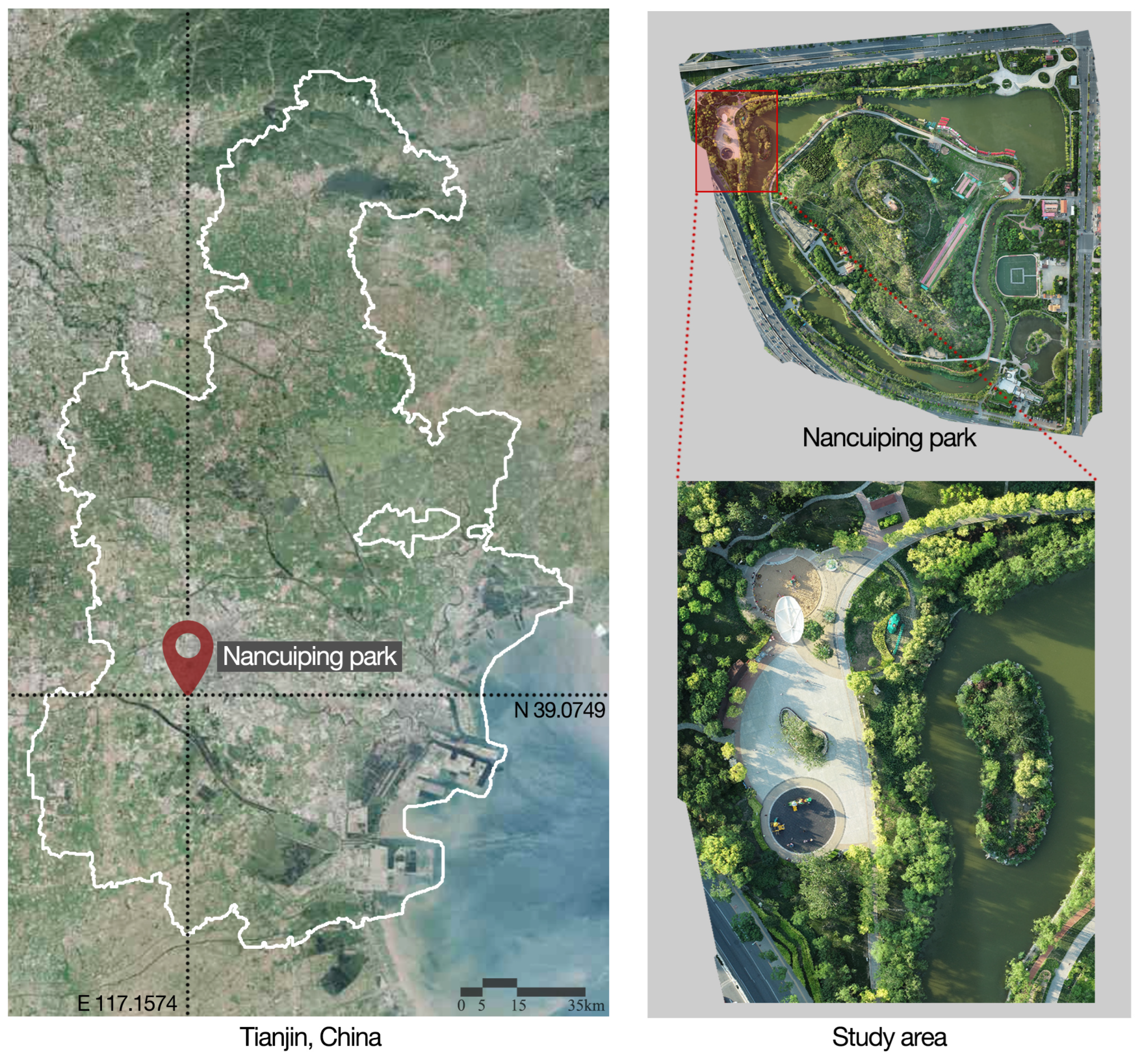
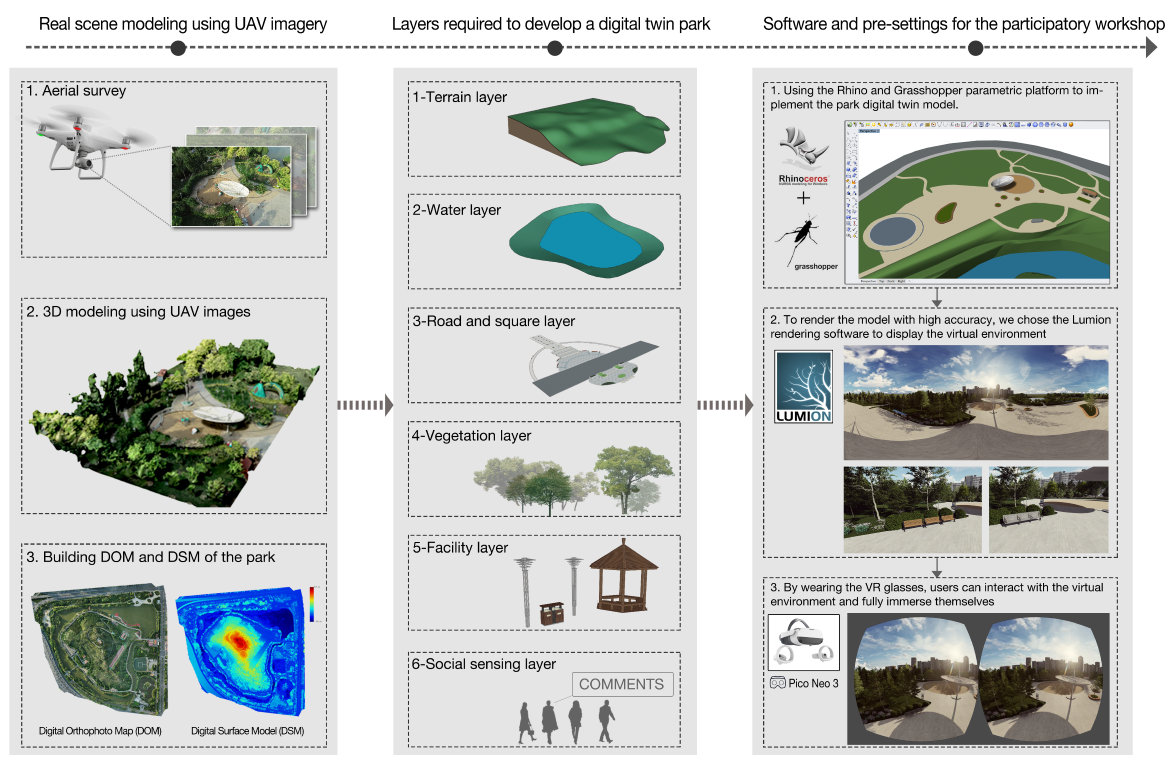
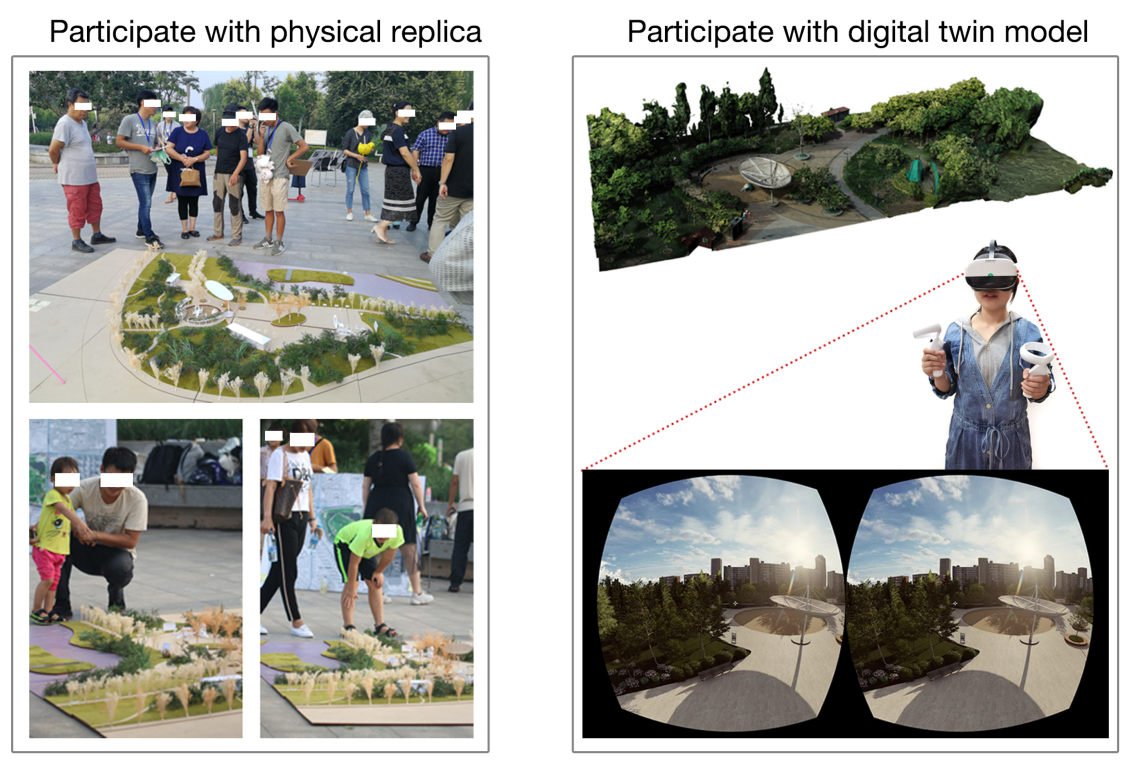
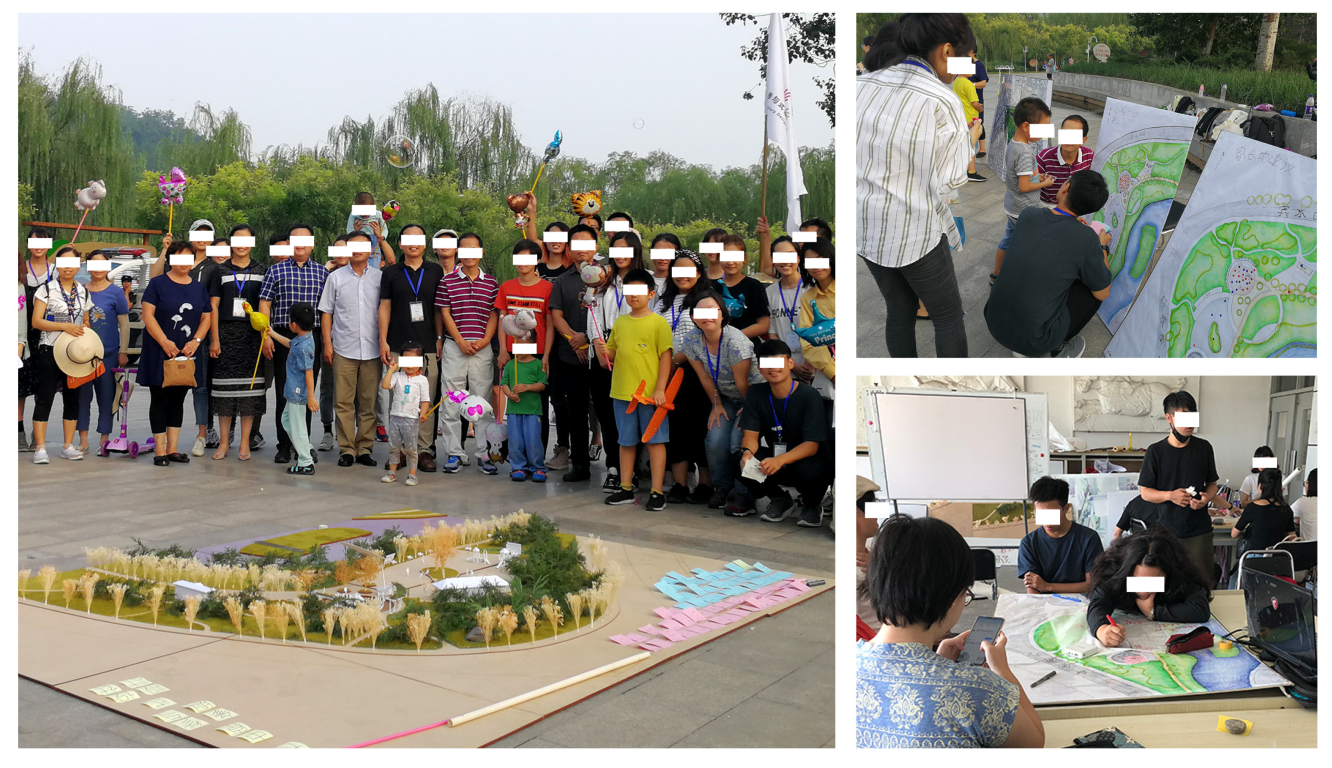
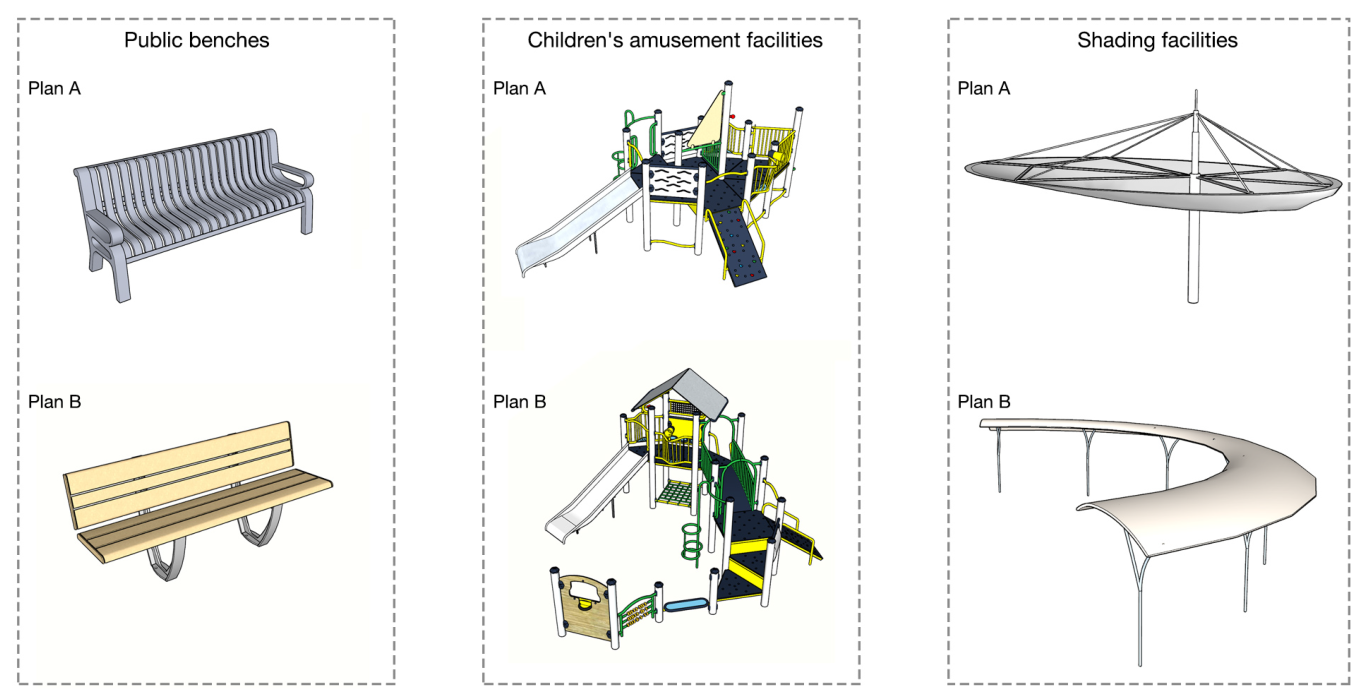

Publisher’s Note: MDPI stays neutral with regard to jurisdictional claims in published maps and institutional affiliations. |
© 2022 by the authors. Licensee MDPI, Basel, Switzerland. This article is an open access article distributed under the terms and conditions of the Creative Commons Attribution (CC BY) license (https://creativecommons.org/licenses/by/4.0/).
Share and Cite
Luo, J.; Liu, P.; Cao, L. Coupling a Physical Replica with a Digital Twin: A Comparison of Participatory Decision-Making Methods in an Urban Park Environment. ISPRS Int. J. Geo-Inf. 2022, 11, 452. https://doi.org/10.3390/ijgi11080452
Luo J, Liu P, Cao L. Coupling a Physical Replica with a Digital Twin: A Comparison of Participatory Decision-Making Methods in an Urban Park Environment. ISPRS International Journal of Geo-Information. 2022; 11(8):452. https://doi.org/10.3390/ijgi11080452
Chicago/Turabian StyleLuo, Junjie, Pengyuan Liu, and Lei Cao. 2022. "Coupling a Physical Replica with a Digital Twin: A Comparison of Participatory Decision-Making Methods in an Urban Park Environment" ISPRS International Journal of Geo-Information 11, no. 8: 452. https://doi.org/10.3390/ijgi11080452
APA StyleLuo, J., Liu, P., & Cao, L. (2022). Coupling a Physical Replica with a Digital Twin: A Comparison of Participatory Decision-Making Methods in an Urban Park Environment. ISPRS International Journal of Geo-Information, 11(8), 452. https://doi.org/10.3390/ijgi11080452





